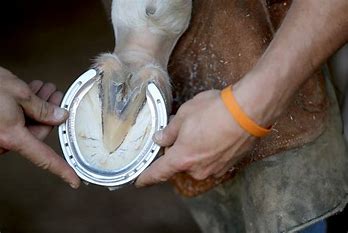
Any racehorse trainer will tell you that the modern Thoroughbred is frailer than ever before, and feet are a constant problem. Bruising of soft soles, wear and tear and low heels are just some of the issues facing trainers wishing to keep their horses sound. Many of these problems arise from the need to apply shoes for roadwork and so on. No modern Thoroughbred races without shoes, even if light steel plates are de rigeur nowadays.
It's a common misconception that the hoof material is a static inanimate mass covering the inside, which is the element that sustains bruising. This is not so. Barfoot hooves are flexible in order to absorb the shock of impact and to provide an elastic rebound as a horse moves off. This motion absorbs concussion and improves blood flow, but is constrained by the use of shoes.
Typically hooves expand during impact and mid stance and heels contract during the start of a stride as the hoof leaves the ground. Unsurprisingly, heel expansion is greater the faster the pace, but contraction is the same whatever the gait of the horse. This is accentuated during the summer months, when watered ground can lead to inconsistency, and sore shins, amongst other issues.
Ground-breaking research in Belgium has discovered that conventional shoes restrict heel expansion by over a third, risking greater concussion. Pilot studies have been conducted on warm bloods with split shoes, where instead of a single toe clip, two additional clips are installed on either side. The shoe, once fitted, is then sawn in two at the apex, so the two parts work independently of each other.

Whilst this hasn't yet been tested on Thoroughbreds for racing, and the two-bit shoe could have implications for fallen riders, the concept that shock absorption could be reduced would be widely welcomed among trainers.
Recent advances in technology in training horses have largely been confined to nutrition and blood testing. Focusing on hoof soundness would give every opportunity to add further runs per horse per season, stretching a diminishing horse population over the season's races and maintaining or enhancing field sizes.
Making our horses last longer can only be a good thing.